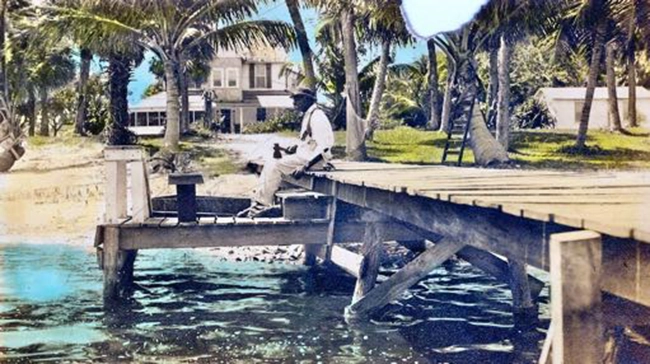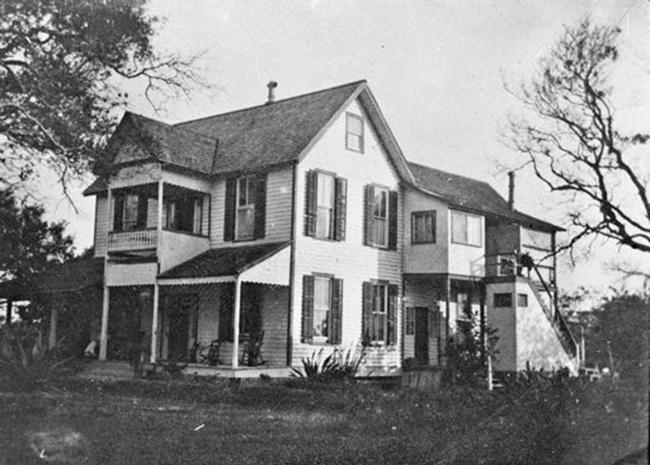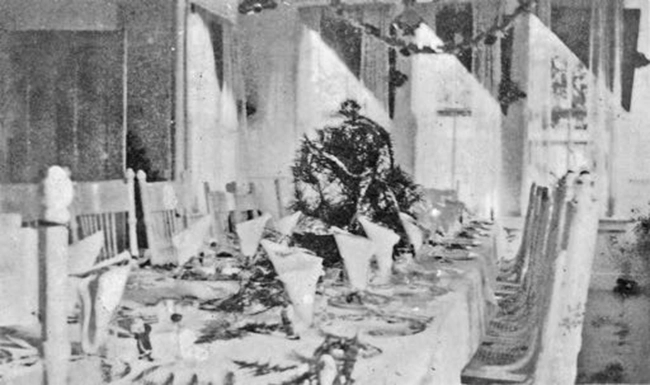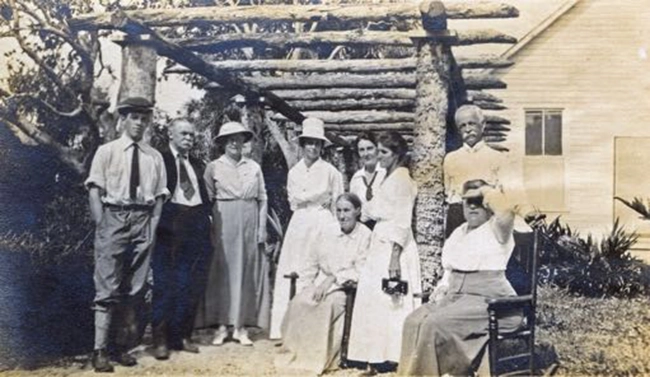The Legacy of The Carlin House: A Beacon of Hospitality in Historic Jupiter
![]() 6 min read
6 min read
Nestled within the lush landscapes of Jupiter, Florida, The Carlin House stands as a testament to the town’s vibrant history and enduring charm. Established in 1887, this iconic structure was more than just a building; it was a cornerstone of community life and a hub of hospitality that welcomed visitors with open arms. As we explore the history of this landmark, we invite you to celebrate Arbor Day with us. Join us for a special “Native Plants of the ONA” tour on Arbor Day, April 26th. This occasion not only accentuates the exquisite natural beauty of our region but also honors the historical importance of sites such as The Carlin House.

Colorized photo of Adam Bryant cracking conch on the Carlin House dock circa 1928
The Origins of The Carlin House
The story of The Carlin House begins with Capt. Charles R. Carlin, the keeper of the Jupiter Life Saving Station, who built the residence for his family. Quickly realizing the demand for lodging in the budding town of Jupiter, the Carlins opened their doors to travelers, making it the first non-governmental permanent residence in the area. By winter of the same year, it had become a bustling hotel, drawing guests who were keen to experience the beauty and tranquility of Jupiter. Mary Joyner Carlin, the Captain’s wife and Jupiter’s first postmaster, operated the hotel with her daughters. The family also had at least one African American employee at any given time. The longest-lasting of these was Adam Bryant: handyman, fisherman, baker, and brewer of famously strong coffee.
A Hub of Activity and Culture
Throughout its early years, The Carlin House was more than just a place to stay; it was a cultural hub. Located near the transit routes of the Indian River steamboats and the Jupiter & Lake Worth Railway (Celestial Railroad), it connected guests from all walks of life. The hotel thrived even as the transportation landscape changed, adapting to the arrival of Henry Flagler’s FEC Railway, which caused the decline of the steamboat and Celestial Railroad.

The Carlin House circa 1912
The Transition to an Upscale Seasonal Boarding House
As the 20th century dawned, The Carlin House shifted from a typical hotel to an upscale seasonal boarding house. Extensive additions were made to the house including, expanding and improving the main house as well as the addition of several cottages and a tennis court to the grounds. This transition marked a new era for the establishment, catering to a more refined clientele including doctors, lawyers, and businessmen who sought a quieter alternative to the bustling Palm Beach Island. Western Union had its Jupiter office next door, making it convenient for guests to communicate with their business interests and check on their stocks. The house was renowned for its exceptional service and fine dining, often hosting luminaries and financial tycoons like William Sperry, who appreciated the high standards maintained by the Carlin family.

The Carlin House dining room
The Carlin House as a Culinary Destination
The dining experience at The Carlin House was legendary. Under the culinary direction of the Carlin family, the dining room became a gathering place not just for hotel guests but also for celebrities and notable figures from Palm Beach Island. This reputation for fine dining was integral to the hotel’s charm, making it a preferred destination for those in search of exquisite meals in a serene setting.
The Decline and Eventual Closure
Despite its success, The Carlin House could not withstand the changing tides of history. With the onset of World War II and the passing of Mary Carlin in 1944, the main house began to fall into disrepair. By the early 1950s, the once vibrant hotel had ceased operations, and the main structure was eventually demolished in 1961, making way for modern development.

Mary Carlin seated at The Carlin House pergola, surrounded by daughters Ella, Emily, and Nauman. On the left are the Dumas Family of Lowell, MA who spent many winters at the Carlin House. On the right are E. B. “Ned” King of the Western Union office and his wife, Nora. (LRHS Carlin Collection)
The Carlin House Today: A Legacy Remembered
Though the physical structure of The Carlin House no longer exists, its legacy lives on through the stories and memories preserved by the community and the Loxahatchee River Historical Society. It remains a symbol of Jupiter’s rich historical tapestry and a reminder of the town’s evolution from a simple pioneer settlement to a thriving community. If you would like to learn more about the fascinating history of The Carlin House, copies of The History of The Carlin House written by William Carlin White, grandson of Charles and Mary Carlin, can be purchased at the gift shop- limited quantities available.
Connecting Past and Present: Arbor Day Celebrations
Reflecting on the legacy of The Carlin House, we also look forward to celebrating Jupiter’s natural and historical heritage during the Arbor Day festivities. These events provide a fantastic opportunity to engage with the flora and fauna of the Jupiter Inlet Lighthouse and to forge deeper connections with the history that has shaped our community. Join us for the “Native Plants of the ONA” tour for an enriching experience that blends educational insights with conservation initiatives.
The Enduring Legacy of The Carlin House
While The Carlin House has long since vanished from Jupiter’s physical landscape, it remains a significant part of the area’s history. This landmark not only served as a home and hotel but also as a vibrant community hub. Its walls witnessed the comings and goings of pioneers and entrepreneurs, the whispers of local gossip, and the laughter of countless guests—elements that helped knit the fabric of the community.
Today, as we strive to honor and retain our rich local heritage, The Carlin House serves as a powerful reminder of the importance of preserving such historical treasures. As we walk the trails of the Jupiter Inlet Lighthouse Outstanding Natural Area, we not only enjoy our natural surroundings but also protect the beauty of these natural places for future generations.
FAQs
What has become of The Carlin House property?
The property that once hosted The Carlin House has been redeveloped into Jupiter Inlet Condominiums, marking a new chapter for this historic site.
What events led to the decline and eventual closure of The Carlin House?
The decline of The Carlin House began with World War II disruptions and the death of Mary Carlin in 1944, leading to neglect and disrepair, culminating in its closure and eventual demolition in 1961.
What led to the transition of The Carlin House from a hotel to a seasonal boarding house?
The Carlin House evolved from a bustling hotel to an upscale seasonal boarding house to cater to a more refined clientele seeking a quieter, more exclusive experience away from the busy Palm Beach area.
